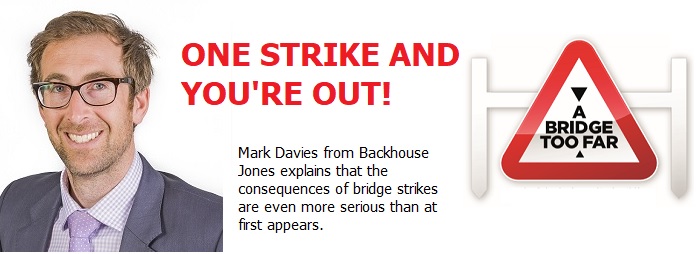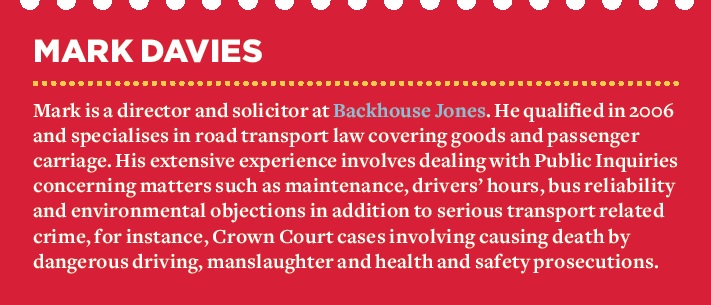Bridge strikes have always been something to be avoided for obvious reasons. Here Mark Davies from Backhouse Jones explains that the consequences are even more serious than at first appears.

They have now taken on a greater level of importance for commercial vehicle operators for two reasons; one, the Traffic Commissioners have started to call Public Inquiries where an operator has been involved in a bridge strike incident and two, buoyed by recent successes in Court, Network Rail are actively seeking to recover all costs from the operator, including compensation they are obliged to pay train companies for delays to services. It goes without saying the costs of a bridge strike are significant.
The Traffic Commissioners have started to call Public Inquiries where an operator has been involved in a bridge strike incident. Even operators who have a blemish free record find they are also brought to the Inquiry room, with both their repute and that of their transport manager(s) being called into question, where the only issue before the Commissioner is the bridge strike itself. Furthermore, drivers are being called to driver conduct hearings and licences suspended for as long as twelve weeks.
It is noteworthy that for an offence of falsifying a tachograph, the starting point in the Traffic Commissioners Guidelines is a 28-day period of suspension. So why is it that bridge strikes have suddenly achieved this elevated status – above the level of an offence for dishonesty?
According to data from Network Rail an average of five bridge strikes happen each day across the UK and the majority involve commercial vehicles. The total cost to the UK taxpayer is put at £23million a year.
Network Rail launched a campaign in 2018 – Lorries Can’t Limbo - to raise awareness, and through its research found that 43% of lorry drivers admit to not checking their vehicle height before embarking on a journey, while more than half report not taking low bridges into account. In light of their findings, guidance has been issued to both operators and drivers seeking to raise awareness and set out best practice for avoiding bridge strikes.
However, Network Rail have gone further still. They have implemented a process which identifies the operator and notifies the relevant Traffic Commissioner immediately after a bridge strike occurs.
The upshot is a letter to the operator requiring an explanation of the incident and a Public Inquiry. In response to the letter, operators are expected to lay out in full their systems. This is where you want to be able to confirm that you have implemented the Network Rail guidance and drivers have been trained on those systems.
Furthermore, operators are expected to submit a copy of their report into the incident. Commissioners are criticising operators if the report is lacking, particularly if it does not set out a list of recommended improvements to be implemented to avoid further incidents. We strongly advise operators to review their policies now and update them to comply with the Network Rail guidance. The guidance for drivers should be issued and form part of a training session where the drivers sign to confirm they have received the guidance and understand its contents.
The main features of the guidance are:
• Route planning to ensure low bridges are avoided;
• Avoid using satnav systems that are not specifically for commercial vehicles;
• Ensure the correct height is displayed for the vehicle combination on the in-cab height indicator. A way of ensuring this is done is by adding a check of the height indicators to a documented gate house check that you should be undertaking of a selection of vehicles before they leave the operating centre. Note, that it is an offence for a vehicle over three metres not to display the correct maximum height on the in the cab indicators;
• Ensure that the trailer height (when connected to the fifth wheel) is displayed on the trailer headboard;
• Ensure that height readings are given in feet and metres or provide drivers with a metric/imperial conversion chart. An error in conversion is often the reason that height indicators are set incorrectly. Traffic Commissioners are unlikely to be sympathetic where an incident has occurred for this reason;
• Routes are expected to be assessed, particularly around known delivery points or operating centres. The risk of bridge strikes should be assessed based on the height and width of the vehicle, and its load or equipment. The traffic planners are central to ensuring routes are appropriate for the size of the vehicle and hazards and identifying hazards along the route.
PSV operators should be informing the Traffic Commissioner of a bridge strike incident in accordance with section 20(1) of the Public Passenger Vehicles Act 1981 on the basis that it is an incident that “may affect the safety of occupants of the vehicle or of persons using the road.” However, whilst there is no similar provision for HGV operators, Traffic Commissioners have stated that they consider a bridge strike to be something which HGV operators should be notifying and criticising operators when a notification has not been provided.
Often bridge strikes occur due to deviations from the expected route, usually due to road works or closures. The way you deal with diversions will be scrutinised by the Traffic Commissioner. It is important to have a policy in place that drivers must contact the planners if they have to go off route.
In our experience, very few operators are going further than training drivers to be aware of their vehicle height and set the in-cab indicators accordingly. No checks are being done to ensure the indicators reflect the actual height of the vehicle and this breeds complacency. Also ask yourself the question, how do the drivers get from point A to B? Are the satnav systems or phone apps they use HGV specific? This is a common own goal and one that is deeply embarrassing when it is uncovered as being the reason for the incident.
Editor’s Note: This risk might be covered by a company’s fleet insurance policy however, as all policies are different it’s important for operators to check whether they are covered or not.
